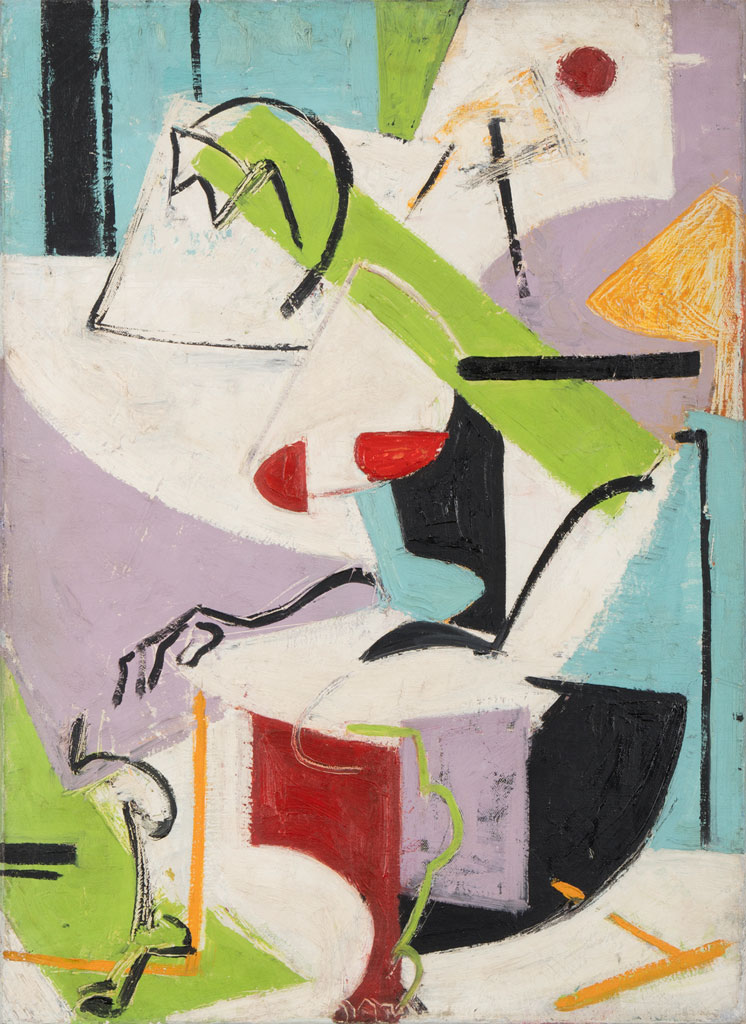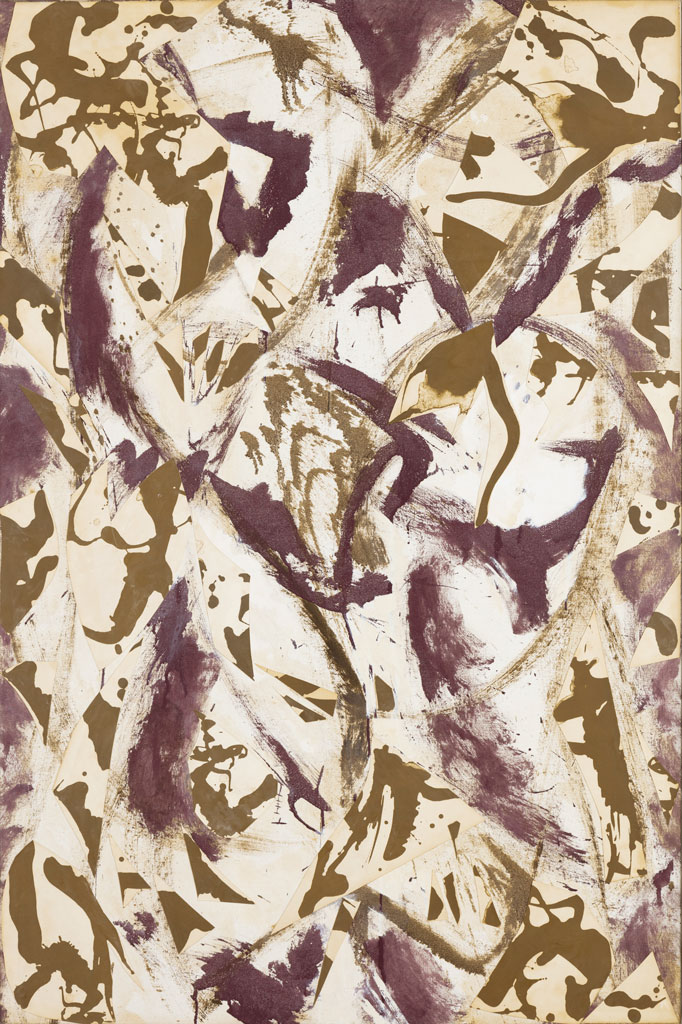ART-PRESENTATION: Lee Krasner-Collage Paintings 1938-1981
 Lee Krasner is considered one of the most critical figures in the evolution of American art in the second half of the 20th century. Lee Krasner was the only woman among originators of Abstract Expressionism, she nevertheless found relatively little recognition until some years after the death of her husband, Jackson Pollock, in 1956. Krasner committed to a six-decade persistent exploration of novel approaches to painting and collage.
Lee Krasner is considered one of the most critical figures in the evolution of American art in the second half of the 20th century. Lee Krasner was the only woman among originators of Abstract Expressionism, she nevertheless found relatively little recognition until some years after the death of her husband, Jackson Pollock, in 1956. Krasner committed to a six-decade persistent exploration of novel approaches to painting and collage.
By Efi Michalarou
Photo: Kasmin Gallery Archive
Featuring several masterpieces from the 1955 debut of Krasner’s collage paintings at the Stable Gallery, as well as significant works from the artist’s 2019-21 traveling European retrospective, the exhibition “Le Krasner Collage Paintings 1938-1981” provides the audiences with the opportunity to further examine one of Krasner’s most innovative practices. Throughout her career, Lee Krasner’s tireless and fierce self-examination compelled the artist to destroy previous works and reconstitute their elements into new compositions. This practice of reclaiming past works of her own, as well as of those of her husband, Jackson Pollock, resulted in many of Krasner’s most novel bodies of work in which elements of painting, drawing, and collage coexist in dramatic compositions. Increasingly regarded as one of the most philosophical and unwavering pioneers of the Abstract Expressionist movement in America, Lee Krasner’s collage paintings represent some of the artist’s most conceptual and emotionally charged works. Included in the exhibition are pivotal works from the exhibition “Lee Krasner Collages” at the Stable Gallery, New York, in 1955. “Stretched Yellow” (1955) and “Blue Level” (1955), which were shown in this exhibition, are two of a concise group of five works created in the same year in the same imposing vertical scale; the latter of which was also featured in the artist’s recent traveling retrospective. Following the recent close of the retrospective “Lee Krasner: Living Colour”, a number of works from the exhibition is also included. With “Bald Eagle” (1955) Krasner masters the all-over composition and conjures the cut-outs of Henri Matisse, while remaining acutely self-referential in her bold amalgamation of unprimed canvas with parts of Jackson Pollock’s drawings from the 50s. “Imperfect Indicative” (1976) belongs to “Eleven Ways to Use the Words to See,” a series in which Krasner integrated early charcoal drawings that were realized under the tutelage of Hans Hofmann between 1937 and 1940. Executed during the same period of the charcoal drawings, “Seated Figure” (1938-39) is the earliest known collage painting by Krasner. A formal feat inspired by Picasso’s cubist style, this work reveals Krasner’s burgeoning interest in integrating collage techniques with oil painting on canvas and linen. Another noteworthy example is “To The North” (1980), made just four years before the artist’s death, which reveals a degree of assuredness in the starkness of its large pictorial components, making this piece one of the most mature and resolved of Krasner’s collage paintings.
Born in New York, to a Russian Orthodox Jewish family, Lee Krasner pursued a formal art education at several institutions in New York, including the Women’s Art School of Cooper Union, the National Academy of Design and the Art Students League. In 1937, Krasner began taking classes with Hans Hofmann, who would radically influence her mature, abstract style. Throughout the 1930s and 40s, Krasner became fully engaged in the New York art scene and integrated herself into contemporary circles that included Jackson Pollock, whom she married in 1945. Though an established artist already before she met Pollock, Krasner’s relationship with the talented, yet troubled painter long overshadowed her own artistic vocation. Arguably the most crucial proponent of Pollock, Krasner was instrumental in propelling his career and cementing his reputation as the most influential living American artist, having introduced him to Willem de Kooning, Clement Greenberg and Peggy Guggenheim, as well as other key figures. Living with Pollock at their home near The Springs, Long Island, Krasner developed some of her most compelling series, including her Little Image paintings. Defined by thick impasto and repetitive abstract symbols, these works are recognized as among her most noteworthy contributions to Abstract Expressionism. Following Pollock’s death from an automobile accident in 1956, Krasner dedicated the remainder of her life to solidifying Pollock’s legacy, while continuing her own artistic endeavors. During this time of newfound solitude, Krasner realized her iconic “Umber Paintings”, which convey a distinctive rawness and intensity that was unprecedented in her oeuvre until this point. Fiercely composed of abstract forms through explosive brushwork in a parsed-down palette of primarily umber, cream and white, this series is considered among Krasner’s most psychoanalytically evocative work. From time to time, Krasner incorporated staring eyes, a motif that harkened back to her own earlier work. Other repeated marks suggest foliage, wind, feathers and wings. It is with these works that Krasner further delved into ideas about self-knowledge. Works from the 1960s, which stand as vehicles by which the artist confronted her turbulent 11-year relationship with Pollock and the effects of his death in a particularly poignant and personal mode of expression. At once unruly and lyrical, each canvas becomes animated by Krasner’s individual and newly powerful backhand gesture, advancing in a rhythmic motion from right to left in vast, curvilinear sweeps. Vigorously thrusting and stabbing with her brush and body, these works present Krasner’s sophisticated integration of sprays and arcs with nodules of paint. Accordingly, Krasner’s works from the 1960s signal her emergence from behind her husband’s shadow and the beginning of Krasner’s critical recognition of her own unique and noteworthy artistic impulses.
Photo: Lee Krasner, To the North, 1980, oil and paper collage on canvas, 58 1/2 x 64 inches, 148.6 x 162.6 cm, © Pollock-Krasner Foundation, Courtesy Kasmin Gallery
Info: Kasmin Gallery, 509 West 27th Street, New York, Duration: 11/3-24/4/2021, Days & Hours: Tue-Sat 12:00-17:00 (by appointment, book here), www.kasmingallery.com




